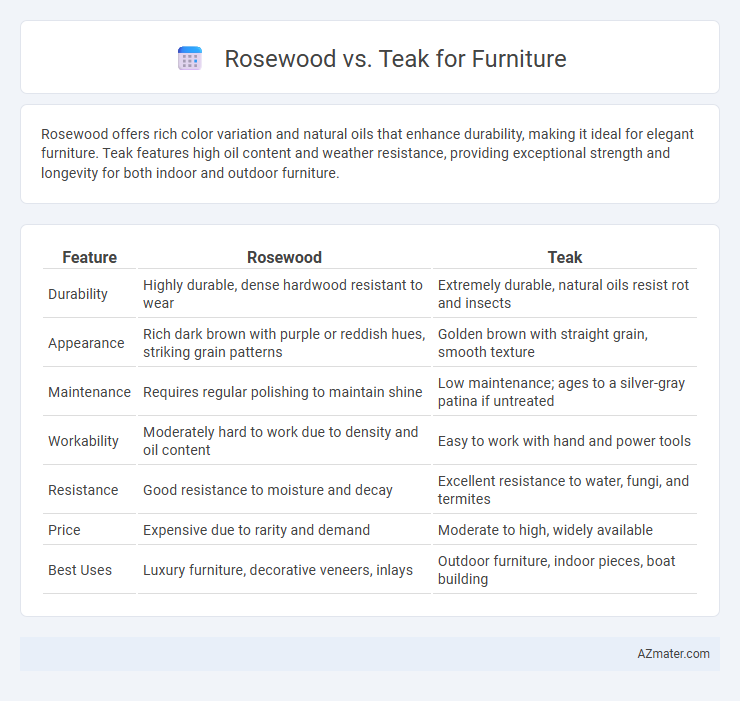Rosewood offers rich color variation and natural oils that enhance durability, making it ideal for elegant furniture. Teak features high oil content and weather resistance, providing exceptional strength and longevity for both indoor and outdoor furniture.
Table of Comparison
| Feature | Rosewood | Teak |
|---|---|---|
| Durability | Highly durable, dense hardwood resistant to wear | Extremely durable, natural oils resist rot and insects |
| Appearance | Rich dark brown with purple or reddish hues, striking grain patterns | Golden brown with straight grain, smooth texture |
| Maintenance | Requires regular polishing to maintain shine | Low maintenance; ages to a silver-gray patina if untreated |
| Workability | Moderately hard to work due to density and oil content | Easy to work with hand and power tools |
| Resistance | Good resistance to moisture and decay | Excellent resistance to water, fungi, and termites |
| Price | Expensive due to rarity and demand | Moderate to high, widely available |
| Best Uses | Luxury furniture, decorative veneers, inlays | Outdoor furniture, indoor pieces, boat building |
Introduction to Rosewood and Teak
Rosewood and teak are two premium hardwoods commonly used in high-quality furniture due to their durability and aesthetic appeal. Rosewood is known for its rich, dark hues and intricate grain patterns, making it a favorite for elegant furniture pieces and musical instruments. Teak, prized for its natural oils and resistance to moisture, offers exceptional longevity and is often used in outdoor and marine furniture.
Origin and Availability
Rosewood primarily originates from tropical regions in South America, India, and Southeast Asia, with notable varieties such as Indian Rosewood and Brazilian Rosewood being highly sought after. Teak is native to Southeast Asia, especially Myanmar, Thailand, and Indonesia, renowned for its natural oil content that offers superior durability and water resistance. Availability of rosewood has declined due to restrictions and conservation efforts, while teak remains more accessible, supported by sustainable plantations and regulated export policies.
Durability and Strength Comparison
Rosewood offers exceptional durability with its dense grain and natural oils that resist decay and insect damage, making it a sturdy choice for furniture. Teak is renowned for its superior strength and high oil content, providing outstanding weather resistance and longevity in both indoor and outdoor settings. Both woods deliver excellent durability, but teak slightly outperforms rosewood in terms of resistance to moisture and environmental wear.
Visual Appeal: Color and Grain Patterns
Rosewood furniture boasts rich, deep reddish-brown hues with striking dark veining, creating luxurious and dramatic visual appeal. Teak features warm golden-brown tones with a smooth, straight grain pattern that exudes timeless elegance and natural warmth. Both woods offer distinct aesthetic qualities, with rosewood providing bold contrast and teak delivering subtle, consistent beauty for furniture design.
Resistance to Pests and Decay
Rosewood exhibits strong natural resistance to pests and decay due to its dense grain and high oil content, making it highly durable for furniture use. Teak contains natural oils and silica, providing excellent resistance to termites, fungal attacks, and moisture, which enhances its longevity in various environments. Both woods are prized for their durability, but teak's superior oil content offers exceptional protection against weathering and decay.
Maintenance and Care Requirements
Rosewood furniture demands regular polishing and humidity control to prevent cracking and maintain its rich sheen, requiring moderate maintenance. Teak is highly durable and naturally resistant to weather and pests, needing only occasional cleaning and oiling to preserve its golden hue. Both woods benefit from avoiding prolonged exposure to direct sunlight and moisture to extend furniture lifespan.
Price and Affordability
Rosewood furniture generally commands a higher price due to its rich grain patterns and durability, often making it less affordable for budget-conscious buyers. Teak, while still a premium hardwood, tends to be more cost-effective because of its widespread availability and natural resistance to weathering. Both woods offer long-lasting furniture options, but teak provides a better balance of quality and affordability for most consumers.
Eco-Friendliness and Sustainability
Rosewood and teak differ significantly in eco-friendliness and sustainability; rosewood faces critical endangerment due to overharvesting and illegal logging, making it a less sustainable choice. Teak, especially plantation-grown teak, offers higher sustainability with faster growth cycles and responsible forestry management that reduces environmental impact. Certified teak from sources adhering to FSC (Forest Stewardship Council) standards ensures eco-friendly furniture production compared to the increasingly restricted availability of rosewood.
Best Uses: Indoor vs Outdoor Furniture
Rosewood's dense grain and natural oils make it ideal for indoor furniture, offering durability and a rich finish that resists wear and pests without harsh chemicals. Teak contains high levels of natural oils and silica, providing exceptional weather resistance, making it the preferred choice for outdoor furniture exposed to sun, rain, and humidity. Both woods balance aesthetics and functionality, but rosewood excels in indoor settings while teak delivers superior longevity outdoors.
Which is Better: Rosewood or Teak?
Rosewood offers a rich, dark hue with intricate grain patterns, making it ideal for luxurious, ornamental furniture, while teak is prized for its exceptional durability and natural resistance to water and pests, perfect for outdoor or high-traffic pieces. Teak's high oil content ensures longevity and minimal maintenance, whereas rosewood's appeal lies in its aesthetic value and smooth finish but may require more care to prevent damage. Choosing between rosewood and teak depends on whether durability or visual elegance is the priority for your furniture needs.

Infographic: Rosewood vs Teak for Furniture
 azmater.com
azmater.com